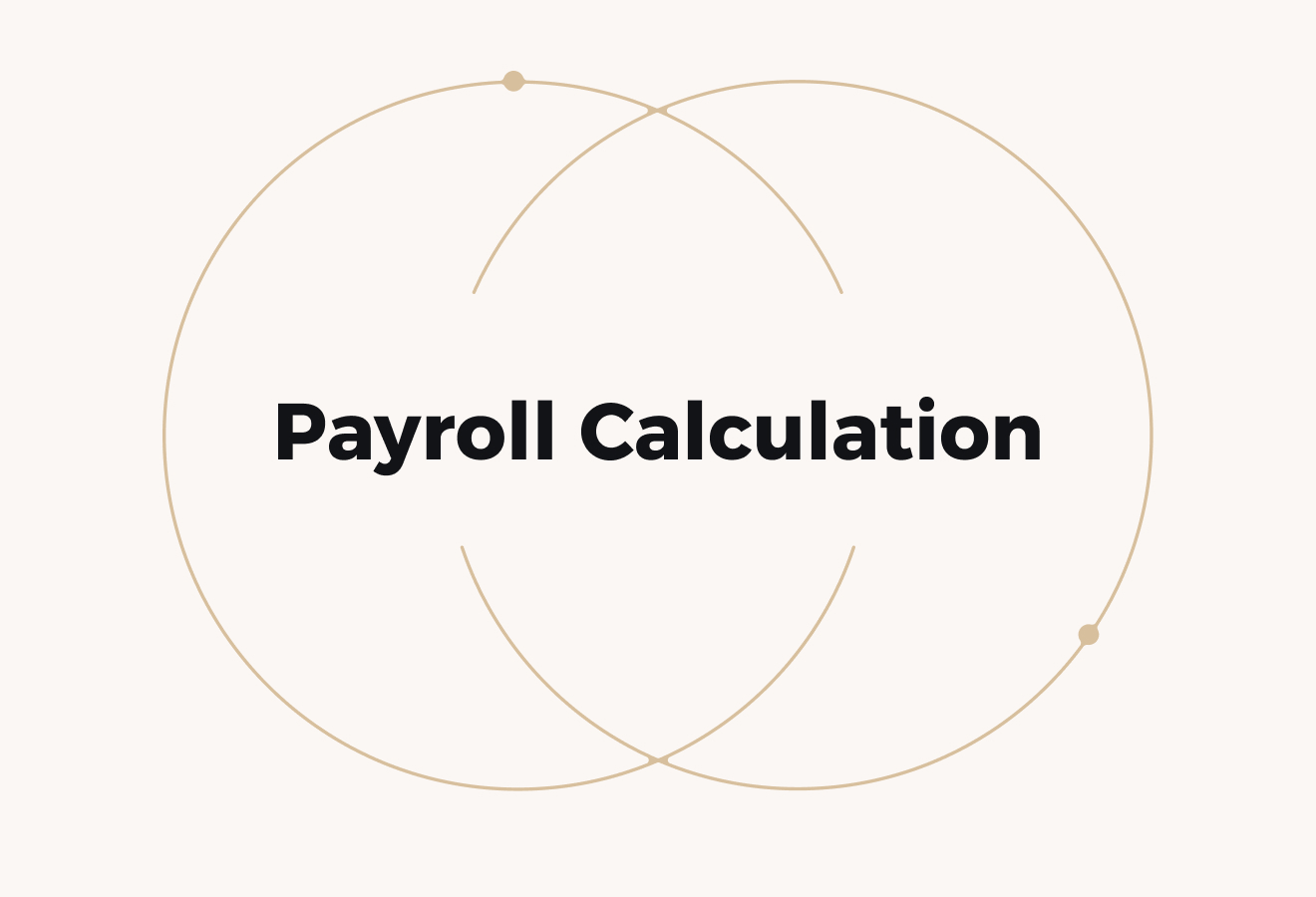How Is Payroll Calculated? A Simple Guide for Global Businesses

How Is Payroll Calculated? A Simple Guide for Global Businesses
Automating payroll processes has made pay runs quicker, but it does not remove the need to understand the underlying calculations. The automation of payrolls may simplify routine tasks, yet payroll managers still need clarity on why gross and net pay differ, or what makes up the final deductions. For international operations, this article explains global tax and deduction considerations, including social security, pension schemes, and reporting obligations, to help you maintain accurate and compliant payroll.
Cercli's global HR system helps your organisation manage these regulations by consolidating withholding amounts and employer contributions in a single location, making payroll across multiple countries straightforward.
What Are Payroll Deductions and Contributions?

Payroll charges cover sums levied on wages and salaries that governments use to fund specific programmes, such as:
- Pensions
- Health care
- Unemployment insurance
Employers usually withhold the employee portion from gross pay and then remit that sum to the relevant government authority on behalf of the worker. Employers often carry additional liabilities, too, in the form of employer contributions, workers’ compensation levies, and employer-specific charges that some jurisdictions impose directly.
How Countries Treat Payroll Deductions Differently
Different countries use the term in various ways. Some treat deductions primarily as social security contributions taken from employees and matched by employers. Others use a broader definition that includes all employer costs of employing staff, from payroll-related insurance to local levies.
In certain places, such as Australian states and territories, the term refers to an employer-paid tax calculated on the total payroll bill.
The Global Advantage of Dubai and the UAE
When managing payroll internationally, the regulatory environment significantly affects complexity. Jurisdictions such as Dubai and the wider United Arab Emirates (UAE) stand out for their streamlined structures.
For expatriates, the absence of personal income tax removes a significant layer of:
- Withholding complexity
- Focusing payroll on social contributions for nationals
- Pension requirements (like the DIFC's DEWS scheme)
- Other required contributions
This transparent and competitive system is a key factor in the region’s strength as a business destination.
Payroll Charges You Will Commonly Encounter
Which charges can appear on a payroll?
Expect some or all of these, depending on the employee’s location:
- Income tax withheld under schemes such as PAYE
- National Insurance or social security contributions for employees and employers
- Unemployment insurance contributions
- Health and long-term care insurance contributions
- Pension fund or retirement contributions
- Workers’ compensation levies and disability insurance
- Education or training levies
- Church tax or solidarity levies, where applicable
- Self-employment equivalents where contractors are treated as workers for particular charges
How Are Payroll Deductions Calculated: The Basic Process
What steps do payroll teams follow to determine payroll liabilities? Start with gross pay for the pay period. Identify the base for contributions and subtract permitted pre-tax deductions, such as specific pension contributions or salary sacrifice amounts. Apply the statutory rate or tax table to the relevant base.
Account for rate bands, thresholds, and any caps that limit the amount subject to charge. Calculate employer contributions separately where required, using the employer rate applied to the relevant payroll base. Report the liabilities on the payroll register and remit by the prescribed due date.
How the Contribution Base, Thresholds, and Caps Affect the Figures
The contribution base differs from gross pay when benefits or specific deductions change the base amount. Thresholds determine when a rate applies or when specific contributions kick in. Caps stop contributions once earnings exceed a set limit for the period or year.
Prorating is required for:
- Part-period payments
- Joiners
- Leavers
- Bonuses
These elements change the payroll liability each pay period and influence year-to-date calculations.
Examples of Common Calculation Flows
How would you calculate withheld amounts in practice?
Use a clear template:
- Gross pay for the period.
- Fewer pre-tax deductions than the law allows.
- Equals contribution base.
- Multiply the contribution base by the employee's statutory rate or use the rate table to find the withholding amount.
- Calculate employer contributions by applying the employer rate to the relevant base.
- Record employee and employer liabilities on the payroll register and include them on the payroll return.
Consider this example: A gross pay of 2,500 for a month, a permitted pension deduction of 200, and a statutory employee contribution applied to the base of 2,300. Apply the table or rate to 2,300 to find the withheld sum, and apply the separate employer rate to the appropriate base to get the employer cost.
How Special Payments and Benefits Change Calculations
Bonuses, commissions, taxable benefits-in-kind, expense reimbursements, and taxable allowances may be subject to different tax treatment. Some items are entirely subject to charge, others qualify for exemptions or fixed valuation rules.
Does the worker use salary sacrifice to contribute to a pension? That can reduce the contribution base for certain charges while triggering different reporting requirements.
What Payroll Reporting and Remittance Involve
For each worker, payroll teams prepare a payroll register that lists:
- Gross pay
- Contribution base
- Withheld amounts
- Employer contributions
- Net pay
They submit periodic payroll returns and make remittances by due dates. Year-to-date totals inform end-of-year reporting and the issuance of documents such as P60s or their equivalents. Late payment or inaccurate reporting incurs interest and penalties, increasing compliance risk.
How Payroll Systems and Rate Tables Support the Calculation
Payroll software:
- Stores codes
- Thresholds
- Rate tables
- Cumulative year-to-date figures
The system applies the correct table or formula for each worker per period. Updates to rates or thresholds require a system update and a change control process to avoid miscalculation. Manual checks, reconciliation of payroll liability to bank payments, and regular audits help prevent errors.
Employer Charges In Specific Cases, Such As Australia
In jurisdictions that levy an employer-specific charge, the charge is a percentage applied to the aggregate payroll amount once the employer exceeds a registration threshold. Employers must register, calculate monthly or annual liability, and pay the amount to the state or territory authority.
Exemptions and grouping rules can change which wages count toward the threshold.
Practical Questions Frequently Asked By Payroll Teams
- How do you treat part-year employees or contractors?
- Prorate thresholds and contributions for partial periods and treat contractors in accordance with local definitions, which may differ from those for employees.
- How do tax credits or reliefs enter the calculation?
- Apply credits against the liability as allowed by law and reflect them in the payroll return.
- How do you track year-to-date for changing pay rates?
- Maintain accurate cumulative records in payroll systems and reconcile after each pay run.
Common Pitfalls that Cause Miscalculations
Failing to apply the correct code, overlooking caps or exemptions, misclassifying benefits, ignoring employer registration thresholds, and missing updates to rate tables.
Each of these can produce:
- Incorrect withholding
- Incorrect employer liability
- Reporting errors
Controls to Reduce Payroll Risk
Automated rate table updates, validation rules in payroll software, routine reconciliations between payroll registers and remitted amounts, and transparent processes for:
- Handling joiners
- Leavers
- One-off payments
Regular training for payroll staff and liaison with advisers keeps interpretation issues under control.
Key Questions for Payroll Teams
- Have you confirmed which payments are subject to charge in your jurisdiction?
- Is your payroll software using the current thresholds and rates?
- Do you reconcile the payroll ledger to your bank remittances each period?
Related Reading
- Why Outsource Payroll Processing Services
- Employee Payroll Management
- What Is Payroll Management in HR
- What Is the Payroll Tax Rate
- How Much Does Payroll Processing Cost
How to Calculate Payroll: A Step-by-Step Guide

Start with gross pay and work forward in a clear order. Calculate each statutory contribution and deduction, separate what is withheld from the employee from what the employer pays, and record payroll liabilities for remittance and reporting.
Understanding Payroll Obligations in Context: UAE, MENA, and the US
Payroll rules differ by jurisdiction and by worker type.
In the UAE, expatriates do not pay personal income tax, which simplifies the process, but employers must use:
- WPS (Wage Protection System) to pay salaries
- Budget for end-of-service gratuity for expatriates
- Make pension or social security contributions for UAE and GCC nationals under GPSSA (General Pension and Social Security Authority)
Payroll Obligations: The Contrast Between the UAE and the US
In Dubai International Financial Centre (DIFC) companies, the DEWS (Dubai Employee Workplace Savings) Plan may replace end-of-service entitlements for eligible staff members. The federal unemployment insurance scheme, introduced in Federal Decree-Law No. 13 of 2022, requires monthly deductions from the salaries of covered workers.
By contrast, the US applies payroll taxes to most employees, including Social Security and Medicare contributions, as well as employer-paid unemployment insurance. Which country’s rules cover your payroll this month?
Calculating Payroll: Five Essential Steps
1. Determine Gross Pay
List every component that counts as gross pay for the payroll period.
Include:
- Base salary
- Wages
- Overtime
- Bonuses
- Commissions
- Taxable allowances
Also include cash benefits that are subject to statutory contributions, so you do not understate the contribution base.
2. Identify Which Payroll Contributions Apply To Each Employee
Sort employees by:
- Nationality
- Employment location
- Contract type
For UAE nationals, include GPSSA employer and employee rates. For expatriates in the UAE, include end-of-service liabilities or DEWS where applicable.
For US employees, include:
- Social Security
- Medicare
- Employer unemployment charges
Ask which statutory schemes apply to your employee before you run the calculations.
3. Apply Statutory Rates To Gross Pay
Multiply the relevant contribution rates by the gross pay or by the statutory wage base where caps apply.
Example for UAE:
UAE national on AED 30,000 monthly salary:
- Employee GPSSA contribution at 11 per cent equals AED 3,300
- Employer GPSSA contribution at 15 per cent equals AED 4,500
- Employer total cash cost equals AED 34,500
Example for the US:
US employees earning USD 50,000 annually:
- Social Security at 6.2 per cent equals USD 3,100 each for the employer and employee
- Medicare at 1.45 per cent equals USD 725 each for the employer and employee
The withheld amounts reduce the employee's take-home pay, and the employer records its share as a payroll expense and liability.
4. Separate Withholdings From Employer Charges And Record Payroll Liabilities
Withhold employee contributions from gross pay and keep those funds as liabilities until remitted to the relevant authority: record employer contributions and any payroll charges the employer must pay directly as separate liabilities.
Maintain a schedule of payment due dates and remittance channels so you do not miss deadlines.
5. Reporting Compliance And Filings
Follow local filing rules for returns and employee statements.
- In the UAE, submit salary payments through WPS and file pension contributions as required.
- In the US, file quarterly Form 941 and issue annual Forms W-2 to employees.
To support audits and to prevent interest or penalties from missed filings, keep accurate records of gross pay, deductions, employer contributions, and payment receipts. Are your systems set to produce the reports and remittances on time?
Practical Payroll Controls and Reconciliation
Every pay period, reconcile:
- Payroll journal entries
- Bank payments
- Statutory filings
Track payroll liabilities on the balance sheet until you remit them. Use exception reports to identify and correct misclassifications or incorrect rates before funds are paid to employees or to authorities.
Key Payroll Terms and Inputs
- Gross pay
- Net pay
- Contribution base
- Withheld amounts
- Employee contribution
- Employer contribution
- Payroll liabilities
- Wage base
- Caps
- End-of-service gratuity
- Pension contributions
- Unemployment insurance
- Payroll reporting
- Payroll accounting
Need to Reduce Manual Work and Ensure Compliance Across Countries?
Cercli is designed for organisations in the Middle East that need a flexible, compliant, and reliable way to:
- Manage local
- Remote
- Multi-country teams
As a global HR system, Cercli supports WPS registrations, processes GOSI in Saudi Arabia, handles DEWS contributions, offers multi-currency payroll, provides Employer-of-Record services, and facilitates compliant international contracts in over 150 countries.
Related Reading
- How Does Payroll Processing Work
- AI in Payroll Processing
- Benefits of Payroll Outsourcing
- Payroll Automation Benefits
- Payroll Tax vs Income Tax
Common Payroll Calculation Challenges

Supplemental Wages: Calculating Bonuses, Commissions, and Overtime
Supplemental wages such as bonuses, commissions, and overtime often follow different withholding rules than regular pay. Some jurisdictions allow you to aggregate the bonus with the employee’s regular wages and apply normal rate tables.
Documenting Calculations and Employee Communication
Others expect a flat supplemental rate or a specific percentage method. Determine the process required by local guidance, then configure payroll software to apply that treatment consistently.
Check whether the payment changes:
- Tax brackets
- Social security caps
- Employer contributions
- Record the calculation method and rationale for audit purposes
How will you explain the calculation to the employee so they understand gross pay, contribution base, and net pay?
Multiple Pay Periods and Year-to-Date Adjustments: Keep Cumulative Totals Traceable
Weekly, bi-weekly, and monthly cycles create a running total that affects tax brackets and contribution caps. When you correct an earlier error or add retroactive pay, update year-to-date balances and recalculate withholdings for the current period where required.
Use payroll records that show:
- Gross pay
- Deductions
- Contributions by period
It provides an audit trail for adjustments. Reconcile payroll liabilities to payments made to relevant authorities each month to spot drift between reported payroll and remitted amounts. Who checks your reconciliations, and how often do they run?
Compliance with Changing Rules: Maintain Updates and Testing
Tax rates, contribution limits, and reporting requirements are subject to frequent changes with little notice.
In the MENA region, you may need to adjust:
- Pension contribution rules
- WPS reporting
- End-of-service calculations
In other countries, authorities update wage caps for social security and adjust unemployment rules.
Managing Regulatory Change and System Deployment
To payroll systems with version control and documentation, maintain a process to:
- Receive regulatory updates
- Test changes in a sandbox environment
- Deploy rule updates
For example, in the UAE, nationals are subject to GPSSA deductions, while expatriates follow gratuity or DEWS obligations; therefore, you must apply the correct rule based on nationality and contract type. Who on your team is responsible for regulatory updates and rule deployment?
Accurate Withholdings: From Gross Pay to Net Pay
Begin every calculation with gross pay and determine the contribution base after accounting for permitted pre-tax deductions. Apply the correct tax code or tax bracket, then calculate employee and employer statutory contributions, such as:
- Pensions
- Social security
- National Insurance
Account for exemptions, withholding allowances, and any local caps or thresholds applicable to your situation. Use official tables or an updatable rule engine and run sample payrolls to validate outputs. Provide payslips that clearly separate gross pay, payroll deductions, and net pay, allowing employees to verify withholdings at a glance.
Does your payslip make it easy for employees to confirm their deductions?
Worker Classification: Status Changes Obligations and Risk
Classify each worker as an employee, a contractor, or a temporary worker and document the factors that determine status. Employees usually trigger employer obligations, while contractors generally handle their own payments.
Misclassification risks include:
- Backdated payroll liabilities
- Fines
- Required contribution payments
Cross-Border Work: Managing Jurisdictional Complexity
Remote and cross-border work adds complexity because multiple jurisdictions may claim tax or social security rights over the same individual. Utilize consistent contracts, thorough onboarding checks, and regular reviews, and consult relevant guidance when evaluating classification issues.
Who verifies classification decisions before payroll runs?
Avoiding Errors and Penalties: Controls that Prevent Mistakes
Common mistakes include:
- Incorrect salary entries
- Outdated rates
- Misreported contributions
Build validation rules in payroll software to flag outliers, require approvals for manual changes, and run pre-payroll reports that highlight unusual withholdings or sudden changes to gross pay. Conduct regular audits to compare payroll registers with bank remittances and filings.
Maintain a schedule of filing deadlines and remittance dates to minimize late payments and penalties. Which checks would stop your last error from repeating?
Safeguarding Payroll Information: Protecting Salaries and Bank Details
Payroll contains personal data such as:
- Salaries
- Bank details
- Identification numbers
Apply role-based access, strong authentication, encryption in transit and at rest, and activity logging. Limit who can change pay rates and who can export sensitive files.
Data Protection, Vendor Due Diligence, and Training
For offshore or cloud providers, verify data residency and conduct thorough vendor due diligence that encompasses compliance with local data protection laws and international standards. Train staff on phishing and the secure handling of payroll files to prevent accidental leaks from becoming reportable incidents.
What extra access control would reduce risk in your setup?
Payroll Tools and Software

Payroll tools calculate, deduct, and report payroll obligations so teams do not rely on manual spreadsheets.
They convert gross pay into the:
- Contribution base
- Apply tax codes and tax rates
- Compute income tax by bracket
- Record National Insurance or social security contributions
The software also tracks employer contributions, pension, and other statutory deductions, produces payslips, and prepares returns for filing with relevant authorities.
Why Payroll Software Reduces Manual Work
Automated systems reduce calculation errors when handling complex tables and withholding allowances. They save time on repetitive tasks such as pay run setup and payroll reconciliation.
They maintain audit trails and year-to-date records for each employee, making it easier to meet filing deadlines and remit payroll liabilities to the relevant authorities.
How Payroll is Calculated Step-by-Step
Start with gross pay for the pay period. Subtract pre-tax deductions such as employee pension or approved salary sacrifice to get the contribution base. Apply tax allowances and tax bands to calculate income tax and apply National Insurance or social security rules to compute employee and employer contributions.
Add other statutory deductions, then subtract employee deductions from gross pay to arrive at net pay. Track all withholdings and update year-to-date totals so calculations reflect cumulative thresholds and tax codes.
Which Rules and Figures Feed the Calculation
Tax rates, tax bands, personal allowances, social security rates, employer contribution rates, tax codes, and statutory thresholds all feed the calculation. Payroll calculators and tables in the software must stay up to date when relevant authorities change rates or thresholds.
Integration with HR records ensures that taxable benefits, bonuses, and termination payments are treated in accordance with the correct rules.
How Software Supports Compliance in the Middle East
Good payroll systems support local requirements for reporting and remittance.
They can manage:
- WPS reporting for the UAE
- Calculate GOSI contributions for Saudi Arabia
- Apply GPSSA deductions for Emirati employees
- Handle DEWS obligations
They also generate the files and reports that relevant authorities expect, reducing the risk of penalties for late or incorrect filings.
Key Features When Choosing Payroll Software
Look for automated table updates, configurable rules, and a clear audit trail. Ensure the system handles multi-currency payroll and can produce payslips and statutory reports.
Check for:
- Payroll calculators
- Pay run automation
- Easy payroll reconciliation
- Integration with accounting and HR systems
Employee self-service for payslips and exportable reports for filing are useful for operational efficiency.
How Cercli Supports Payroll Management in the Middle East
Cercli provides organisations in the Middle East with a system to manage payroll and HR operations in line with local requirements.
For payroll computation, Cercli integrates compliance obligations into payroll workflows and manages:
- WPS reporting in the UAE
- Processes GOSI contributions in Saudi Arabia
- Handles DEWS obligations
- Applies GPSSA deductions for Emirati employees
Cercli also supports multi-currency payroll and global compliance, enabling payments in more than 150 countries while consolidating payroll, employee records, and compliance processes into a single system.
Would you like a simple worked example for a pay run in your country or a checklist to compare vendors?
Book a Demonstration to Speak with Our Team
Cercli is built for organisations in the Middle East to manage their entire workforce, whether local or spread across over 150 countries, in a single system.
Run fully compliant payroll across the UAE, Saudi Arabia, and the wider MENA region in multiple currencies with ease:
- Manage leave
- Onboard employees
- Track assets
- Handle global contractor payments
Scale Your Workforce with Global Compliance
Whether you manage 25 employees or scale to over 500 across multiple markets, Cercli combines local expertise with global capabilities, providing your HR team with a simple, compliant system to run operations and pay your workforce anywhere.
Would you like to see how your current payroll would run on Cercli?
How Payroll is Calculated: Clear Steps for Immediate Use
- Start with gross pay, which is the total amount of wages before any deductions.
- Isolate the contribution base by removing pre-tax deductions such as qualifying retirement contributions and approved allowances.
- Apply the correct tax base, then use the local withholding rules or tax brackets to calculate income tax withheld.
- Add employee social contributions where applicable.
- Add employer contributions and payroll charges to compute total employer cost.
- Subtract employee withheld amounts and employee contributions from gross pay to get net pay.
- Record the payroll liabilities, file returns, and remit the obligations on the local schedule.
Which step in your process takes the longest right now?
Key Terms That Govern the Calculation
Gross pay and the contribution base determine the starting base. Withholdings include income tax and employee social insurance. Employer payroll charges include employer social insurance and statutory employer charges like end-of-service liabilities.
Tax rates and tax brackets set the percentage applied to the contribution base. Tax credits and exemptions reduce withholding. Payroll tables and calculators turn those rules into figures for each pay period. Keep a clear link between pay slip line items and the liability records for audits and reconciliations.
Example Calculation: Charges and Employer Costs in Practice
Assume a gross monthly salary of 10,000 in a country with a 10 per cent flat income tax and a 5 per cent employee social contribution plus a 12 per cent employer social contribution. Income tax withheld equals 10,000 × 10 per cent equals 1,000.
- Employee social equals 10,000 × 5 per cent equals 500. Net pay equals 10,000 - 1,000 - 500 equals 8,500.
- Employer cost equals gross plus employer social, which equals 10,000 + 1,200, which equals 11,200.
Check local contribution rates and caps to adjust calculations for your jurisdiction.
Rules for the UAE, Saudi Arabia, and the Wider MENA Region
Many Gulf countries do not levy a broad personal income tax on employment income for expatriates. This is a key advantage. Social insurance and social security primarily apply to nationals and may have varying employer and employee contributions.
Tax residency status, withholding for non-residents, and source rules can change whether income is taxable locally. Contractor payments often follow different withholding rules or none at all, depending on local law and the contractor's status.
How does your team classify contractors versus employees today?
Reporting, Remittance, and Compliance Tasks
Register with the local relevant authority and obtain payroll IDs. Withhold according to the correct schedule:
- Weekly
- Monthly
- Quarterly
File returns with supporting detail and pay liabilities by the deadline to avoid penalties. Keep payslips and payroll registers for the statutory retention period.
Reconcile payroll ledger balances to filings monthly and prepare for audits by maintaining clear documentation for:
- Allowances
- Benefits
- Exemptions
Who on your team is responsible for remittance and reconciliation?
Familiar Sources of Error and Prevention
Using the wrong tables or outdated contribution rates can result in underpayments or overpayments. Misclassifying workers leads to incorrect withholding and late penalties. Failing to include taxable benefits, such as housing allowances or bonuses, inflates net pay and makes errors.
Manual spreadsheets increase risk as payroll complexity grows across borders. Automate rule updates and maintain a single source of truth for employee data to minimize errors.
How Cercli Automates Payroll Calculation and Ensures Compliance
Cercli codifies local rules and social contribution rates, so it automatically withholds updates when the law changes. The system calculates gross-to-net for each pay run using current tables and contribution caps, generates compliant payslips, and prepares remittance files for local authorities and banks.
It supports over 150 countries:
- Multi-currency payroll
- Country-specific pay items
- Contractor payments
- Statutory reports
Book a Demonstration and Request a Sample Payroll Run
Book a demonstration to see how Cercli helps MENA organisations simplify HR, payroll, and global team management, while staying fully compliant. Would you like a sample payroll run for one of your markets?
Related Reading
- Payroll Management Software Features
- Employee Payroll Automation Software
- Best Payroll Software for Small Businesses
- How to Do Payroll for a Small Business










